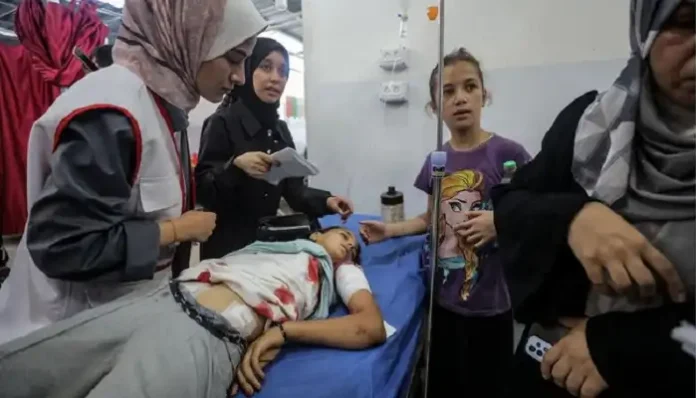Gaza City — In a deeply tragic incident that has sparked global outrage, an Israeli missile strike hit a water distribution point in the Nuseirat refugee camp, Gaza, on Saturday. The attack, which killed at least eight Palestinians — most of them children — occurred as residents were queuing to collect clean water amid a deepening humanitarian crisis.
The Israel Defense Forces (IDF) claimed the missile strike was the result of a “technical malfunction”, stating that the intended target was an Islamic Jihad militant in the vicinity. According to their official statement, the missile “fell dozens of meters off target”, resulting in unintended civilian casualties.
“The IDF regrets the harm caused to uninvolved civilians,” the military said in a statement quoted by Reuters. The statement added that the incident is currently under internal review.
Emergency Doctors: “We Lost Six Children Instantly”
The medical impact of the strike was devastating. Dr. Ahmed Abu Saifan, an emergency physician at Al-Awda Hospital, reported that six children were killed on the spot, with 17 others injured in the blast.
“They were just children — standing in line with plastic containers to get water. We couldn’t even identify some of the bodies,” Dr. Saifan told local media. “This isn’t war. This is a massacre.”
The victims were among dozens of families who had gathered at a makeshift water collection center — a lifeline for Gaza residents amid weeks of water shortages caused by the collapse of essential infrastructure.
Gaza’s Water Crisis: A Deadly Consequence of Blockade
Water has become increasingly scarce in Gaza, as continued Israeli bombardments and an ongoing blockade have crippled fuel supplies, shutting down desalination and sanitation facilities. This has left over two million residents dependent on limited public water points scattered across refugee camps and neighborhoods.
Aid groups and UN agencies have repeatedly warned of a growing risk of disease outbreaks, particularly among displaced children living in overcrowded shelters without access to clean water, hygiene products, or adequate medical care.
“This tragedy was predictable,” said a spokesperson for an international NGO operating in Gaza. “When you attack infrastructure and deprive people of water and sanitation, you’re creating the conditions for catastrophe — and then you’re surprised when it happens?”
Secondary Strike: IDF Hits Gaza Marketplace Hours Later
Just hours after the water distribution site was hit, the IDF reportedly launched another airstrike on a crowded market in central Gaza. The death toll rose to 12, including Dr. Ahmad Qandil, a prominent hospital consultant.
As of this writing, Israel has not issued a statement regarding the marketplace attack.
These back-to-back incidents have prompted condemnation from human rights groups, who argue that the attacks reflect a pattern of disproportionate force and a disregard for civilian safety in one of the world’s most densely populated regions.
Gaza’s Grim Toll: Over 58,000 Dead Since Escalation Began
According to the Gaza Health Ministry, more than 58,000 Palestinians have been killed since Israel’s offensive began last year. More than half of the victims are reportedly women and children. The war has left the coastal enclave in ruins, with millions displaced, often seeking shelter in UN-run schools, makeshift tents, or the rubble of destroyed homes.
“There is no safe place in Gaza,” a displaced mother told reporters. “We are targeted when we sleep, when we pray, and even when we fetch water for our children.”
A Crisis Ignored?
Despite the scale of destruction and humanitarian need, international response has been limited. Western governments continue to provide military and diplomatic support to Israel, while calls for ceasefire agreements are repeatedly delayed or ignored.
Fars News Agency, an Iranian outlet, criticized Western and Israeli-aligned media for downplaying what it labeled as “blatant state terrorism,” accusing them of selectively reporting or omitting the civilian cost of the war.
Whether intentional or not, the deaths of children collecting water highlight the moral and legal crisis at the heart of this conflict. As infrastructure collapses and civilian suffering deepens, excuses like “malfunctions” may no longer suffice.
The world is watching — and many are asking: How many more children must die before accountability becomes unavoidable?


